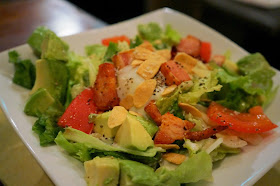Many are familiar with the Gyu Kaku Yakiniku restaurant on the 9th floor of More's City. What many don't know is that there is another smaller Gyu Kaku restaurant located about a block or two away. I had a chance to visit it recently.
.JPG) |
| Entrance to Gyu Kaku - the yellow sign with the lights shining on it. |
This smaller Gyu Kaku is located on the same street as TGI Fridays and Thai Erawan. Walk just a few doors down past Thai Erawan away from Blue Street and you'll come upon it. It's on the second floor. If you don't know where these places are...when walking down Blue Street toward Yokosuka Chuo station, turn left at the last intersection before getting to the station. Also check the
blog map.
The sign is
牛角 - Gyu Kaku. In my
Key Food Kanji Gyu or
牛 is very important. It means beef. Along with pork it is one of the most useful kanji when eating out. Kaku or
角 means horns (among other things). So together it means "horn of the bull."
.JPG) |
| Some counter seating with the waiting charcoal pits |
.JPG) |
| The Essentials - Beer and Charcoal |
The charcoal you see here is called "oga sumi." Pretty much this means charcoal made with sawdust. It is chemical free and almost smoke free. There is a hole in the middle for better air flow. This charcoal burns about 3x hotter than American charcoal.
Gyu Kaku adopted a smokeless grill, which was developed in Nagoya in the mid 1970s. A downdraft system sucks in the smoke right at the grill surface so your clothes will stay pristine. Until the people next to you start smoking of course. To receive full credit and the qualification signature for smokeless grill however, you will have to review details at the
Shinpo website - the self described trailblazer of smokeless grills.
Gyu Kaku was developed by Rex Holdings Japan in the 1990s and now has over 650 restaurants worldwide.
.JPG) |
| Avocado Caesar salad |
The avocado Caesar salad was very good. Topped with garlic chips. Off to a good start. One thing though, if you look closely you can see a partially cooked egg yolk in the middle. If you don't want that in your salad, then try telling them "tamago nashi" or without the egg when you order.
.JPG) |
| Kalbi |
Gyu Kaku has a great English menu. But Kalbi is a very common term if you like yakiniku and is often written as カルビ in katakana. Just about everything here will be delivered to your table for you to cook. That is the whole restaurant concept. You are the chef. Beside beef of course, they also have pork, chicken, and seafood.
.JPG) |
| Some meat cooking along with butter melting |
.JPG) |
| Wakame soup |
Wakame soup is standard fare at yakiniku restaurants. Wakame is seaweed. Don't worry it tastes really good!
.JPG) |
| Squid or Ika |
.JPG) |
| Bibimbap |
Ishiyaki bibimbap is a korean rice dish with meat and veggies mixed in and then cooked in a stone bowl - that's where the ishiyaki comes from. If you order this they will cook it/mix it up for you at your table if you desire.
.JPG) |
| A complimentary after dinner, alcohol free, palette freshener |
At Gyu Kaku, you can go with the all you can eat course or Ala-carte. The "buffet course" as it is called below includes 90 minutes of all you can eat. If you upgrade to the "full satisfaction course" (can't go wrong with that) you will get some better cuts of beef and "select tongue" instead of just "normal tongue." Add in $14 for all you can drink and you're all set.
I think I like this small place better than the larger restaurant at More's only because you seem to get better service due to its small size. Otherwise they serve the same food. The restaurant is on the second floor and is only open for dinner during the week, weekends they are open for lunch. Staff was friendly and the English menu made it all very easy.
Hours: 1600-2400 except Friday and Saturday until 1a.m.
1200-2400 on Saturdays and Sundays. (1a.m. on Sat)
English menu:
One note, Hormone is beef innards - like intestines.
.JPG)
.JPG)
.JPG)
.JPG)
.JPG)
.JPG)
.JPG)
.JPG)
.JPG)
.JPG)
.JPG)
.JPG)
.JPG)
.JPG)
I love this chain, we visited a few of them during our two trips to Japan... reliably delicious.
ReplyDelete